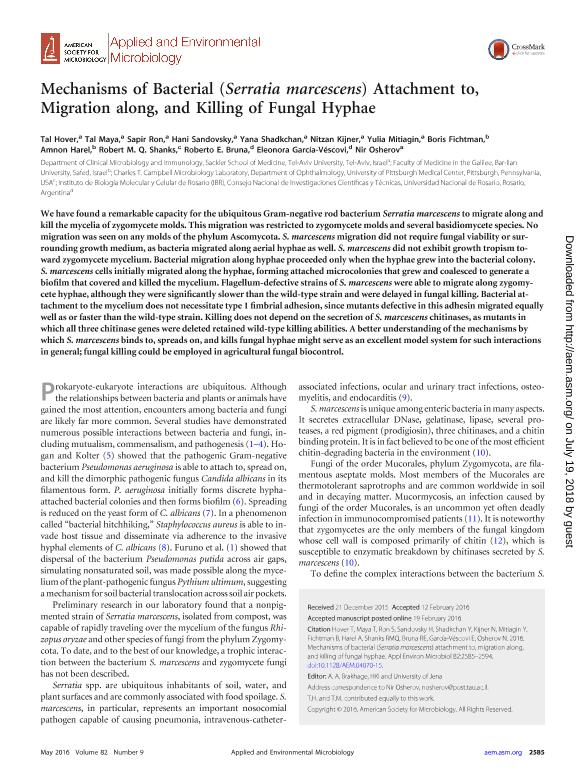Mostrar el registro sencillo del ítem
dc.contributor.author
Hover, Tal
dc.contributor.author
Maya, Tal
dc.contributor.author
Ron, Sapir
dc.contributor.author
Sandovsky, Hani
dc.contributor.author
Shadkchan, Yana
dc.contributor.author
Kijner, Nitzan
dc.contributor.author
Mitiagin, Yulia
dc.contributor.author
Fichtman, Boris
dc.contributor.author
Harel, Amnon
dc.contributor.author
Shanks, Robert M. Q.
dc.contributor.author
Bruna, Roberto Emanuel

dc.contributor.author
Garcia Vescovi, Eleonora

dc.contributor.author
Osherov, Nir
dc.date.available
2018-07-19T18:28:42Z
dc.date.issued
2016-05
dc.identifier.citation
Hover, Tal; Maya, Tal; Ron, Sapir; Sandovsky, Hani; Shadkchan, Yana; et al.; Mechanisms of bacterial (Serratia marcescens) attachment to, migration along, and killing of fungal hyphae; American Society for Microbiology; Applied And Environmental Microbiology; 82; 9; 5-2016; 2585-2594
dc.identifier.issn
0099-2240
dc.identifier.uri
http://hdl.handle.net/11336/52680
dc.description.abstract
We have found a remarkable capacity for the ubiquitous Gram-negative rod bacterium Serratia marcescens to migrate along and kill the mycelia of zygomycete molds. This migration was restricted to zygomycete molds and several basidiomycete species. No migration was seen on any molds of the phylum Ascomycota. S. marcescens migration did not require fungal viability or surrounding growth medium, as bacteria migrated along aerial hyphae as well. S. marcescens did not exhibit growth tropism toward zygomycete mycelium. Bacterial migration along hyphae proceeded only when the hyphae grew into the bacterial colony. S. marcescens cells initially migrated along the hyphae, forming attached microcolonies that grew and coalesced to generate a biofilm that covered and killed the mycelium. Flagellum-defective strains of S. marcescens were able to migrate along zygomycete hyphae, although they were significantly slower than the wild-type strain and were delayed in fungal killing. Bacterial attachment to the mycelium does not necessitate type 1 fimbrial adhesion, since mutants defective in this adhesin migrated equally well as or faster than the wild-type strain. Killing does not depend on the secretion of S. marcescens chitinases, as mutants in which all three chitinase genes were deleted retained wild-type killing abilities. A better understanding of the mechanisms by which S. marcescens binds to, spreads on, and kills fungal hyphae might serve as an excellent model system for such interactions in general; fungal killing could be employed in agricultural fungal biocontrol.
dc.format
application/pdf
dc.language.iso
eng
dc.publisher
American Society for Microbiology

dc.rights
info:eu-repo/semantics/openAccess
dc.rights.uri
https://creativecommons.org/licenses/by-nc-sa/2.5/ar/
dc.subject
Zygomycota
dc.subject
Mucorales
dc.subject
Serratia Marcescens
dc.subject
Fungal-Bacterial Interaction
dc.subject
Migration
dc.subject
Adhesion
dc.subject.classification
Otras Ciencias Biológicas

dc.subject.classification
Ciencias Biológicas

dc.subject.classification
CIENCIAS NATURALES Y EXACTAS

dc.title
Mechanisms of bacterial (Serratia marcescens) attachment to, migration along, and killing of fungal hyphae
dc.type
info:eu-repo/semantics/article
dc.type
info:ar-repo/semantics/artículo
dc.type
info:eu-repo/semantics/publishedVersion
dc.date.updated
2018-07-18T20:41:29Z
dc.journal.volume
82
dc.journal.number
9
dc.journal.pagination
2585-2594
dc.journal.pais
Estados Unidos

dc.journal.ciudad
Washington
dc.description.fil
Fil: Hover, Tal. Tel Aviv University; Israel
dc.description.fil
Fil: Maya, Tal. Tel Aviv University; Israel
dc.description.fil
Fil: Ron, Sapir. Tel Aviv University; Israel
dc.description.fil
Fil: Sandovsky, Hani. Tel Aviv University; Israel
dc.description.fil
Fil: Shadkchan, Yana. Tel Aviv University; Israel
dc.description.fil
Fil: Kijner, Nitzan. Tel Aviv University; Israel
dc.description.fil
Fil: Mitiagin, Yulia. Tel Aviv University; Israel
dc.description.fil
Fil: Fichtman, Boris. Bar Ilan University; Israel
dc.description.fil
Fil: Harel, Amnon. Bar Ilan University; Israel
dc.description.fil
Fil: Shanks, Robert M. Q.. University of Pittsburgh Medical Center; Estados Unidos
dc.description.fil
Fil: Bruna, Roberto Emanuel. Consejo Nacional de Investigaciones Científicas y Técnicas. Centro Científico Tecnológico Conicet - Rosario. Instituto de Biología Molecular y Celular de Rosario. Universidad Nacional de Rosario. Facultad de Ciencias Bioquímicas y Farmacéuticas. Instituto de Biología Molecular y Celular de Rosario; Argentina
dc.description.fil
Fil: Garcia Vescovi, Eleonora. Consejo Nacional de Investigaciones Científicas y Técnicas. Centro Científico Tecnológico Conicet - Rosario. Instituto de Biología Molecular y Celular de Rosario. Universidad Nacional de Rosario. Facultad de Ciencias Bioquímicas y Farmacéuticas. Instituto de Biología Molecular y Celular de Rosario; Argentina
dc.description.fil
Fil: Osherov, Nir. Tel Aviv University; Israel
dc.journal.title
Applied And Environmental Microbiology

dc.relation.alternativeid
info:eu-repo/semantics/altIdentifier/doi/https://dx.doi.org/10.1128/AEM.04070-15
dc.relation.alternativeid
info:eu-repo/semantics/altIdentifier/url/http://aem.asm.org/content/82/9/2585
Archivos asociados
